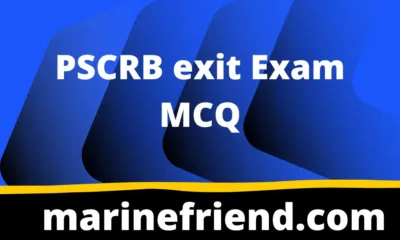PSSR
Pssr exit exam questions and answers part 6

Pssr exit exam questions and answers part 6
Certainly! Here are some multiple-choice questions (MCQs) on the topic of Personal Safety and Social Responsibility (PSSR) for DG Shipping exit exam:
- What does PSSR stand for in the context of DG Shipping’s exit exam?
a) Port Security and Safety Regulations
b) Personal Safety and Social Responsibility
c) Professional Seafarer Standards and Regulations
d) Public Safety and Security Review
Answer: b) Personal Safety and Social Responsibility
- Which international convention outlines the requirements for Personal Safety and Social Responsibility for seafarers?
a) SOLAS (Safety of Life at Sea)
b) MARPOL (International Convention for the Prevention of Pollution from Ships)
c) STCW (Standards of Training, Certification, and Watchkeeping for Seafarers)
d) ISPS (International Ship and Port Facility Security)
Answer: c) STCW (Standards of Training, Certification, and Watchkeeping for Seafarers)
- What is the primary objective of Personal Safety and Social Responsibility training for seafarers?
a) To enhance navigation skills
b) To promote environmental sustainability
c) To ensure the well-being of individuals and promote effective communication
d) To regulate maritime trade routes
Answer: c) To ensure the well-being of individuals and promote effective communication
- According to PSSR regulations, what is seafarers’ responsibility regarding safety?
a) Ensuring only personal safety
b) Ensuring the safety of the ship only
c) Ensuring the safety of themselves and others on board
d) Ensuring the safety of cargo
Answer: c) Ensuring safety of themselves and others on board
- Which of the following is NOT a Personal Safety and Social Responsibility training component?
a) Firefighting techniques
b) First aid and medical care
c) Social media etiquette
d) Abandon ship procedures
Answer: c) Social media etiquette
- What is the purpose of the “Man Overboard” drill, as outlined in PSSR training?
a) To test the effectiveness of lifeboats
b) To practice response to a person falling into the water
c) To simulate a fire emergency
d) To evaluate navigation skills
Answer: b) To practice response to a person falling into the water
- In PSSR training, what does the term “ISM Code” refer to?
a) International Safety Management Code
b) International Security Management Code
c) International Seafarer Management Code
d) International Ship Management Code
Answer: a) International Safety Management Code
- What should seafarers do when discovering a stowaway on board?
a) Offer them employment on the ship
b) Report the stowaway to the master of the ship
c) Ignore the presence of the stowaway
d) Allow the stowaway to remain on board until reaching the next port
Answer: b) Report the stowaway to the master of the ship
- What is the purpose of the “Safety Management System” (SMS) in the context of PSSR?
a) To manage financial transactions
b) To ensure the safety of ship operations
c) To regulate maritime trade routes
d) To oversee crew entertainment activities
Answer: b) To ensure the safety of ship operations
- According to PSSR guidelines, what is the role of a Designated Person Ashore (DPA)?
a) Oversee ship navigation
b) Manage Onboard entertainment
c) Monitor the safety and pollution prevention aspects of ship operations
d) Control cargo loading and unloading
Answer: c) Monitor the safety and pollution prevention aspects of ship operations
- What is the primary purpose of the “Code of Safe Working Practices” on a ship?
a) Regulating meal schedules for the crew
b) Providing guidelines for safe working conditions and practices
c) Dictating dress code for seafarers
d) Ensuring proper maintenance of recreational facilities
Answer: b) Providing guidelines for safe working conditions and practices
- Which document outlines the responsibilities of the ship’s master regarding safety and pollution prevention?
a) Ship’s logbook
b) International Safety Management (ISM) Manual
c) Ship’s entertainment schedule
d) Maritime Labor Convention (MLC)
Answer: b) International Safety Management (ISM) Manual
- What is the significance of the “Muster List” on a ship?
a) It lists the names of crew members.
b) It details the locations of emergency escape routes.
c) It outlines the menu for onboard meals.
d) It provides a schedule of recreational activities.
Answer: b) It details the locations of emergency escape routes.
- What is the purpose of the “International Ship Security Certificate” (ISSC)?
a) To certify the ship’s structural integrity
b) To verify the ship’s age
c) To confirm compliance with international security standards
d) To ensure crew members have valid passports
Answer: c) To confirm compliance with international security standards
- How often should Personal Safety and Social Responsibility training be refreshed, according to STCW regulations?
a) Every five years
b) Every two years
c) Every ten years
d) One-time training is sufficient
Answer: b) Every two years
- In the context of PSSR, what is the purpose of the “Shipboard Oil Pollution Emergency Plan” (SOPEP)?
a) To outline the ship’s emergency evacuation procedures
b) To address pollution prevention and response in case of oil spills
c) To manage onboard waste disposal
d) To schedule routine maintenance tasks
Answer: b) To address pollution prevention and response in case of oil spills
- What does the term “GMDSS” stand for in maritime communication related to PSSR?
a) Global Maritime Display and Safety System
b) General Maritime Distress Signaling System
c) Global Meteorological Data and Safety Service
d) General Maritime Directional Steering System
Answer: b) General Maritime Distress Signaling System
- According to PSSR guidelines, what is the purpose of the “Emergency Position Indicating Radio Beacon” (EPIRB)?
a) To locate the ship’s position during routine navigation
b) To signal distress and provide a location in emergencies
c) To communicate with other ships for social reasons
d) To monitor weather conditions
Answer: b) To signal distress and provide a location in emergencies
- What is the primary focus of the “International Ship and Port Facility Security Code” (ISPS Code) in PSSR training?
a) Fire safety on board
b) Navigation procedures
c) Security measures to prevent terrorism in the maritime industry
d) Crew entertainment activities
Answer: c) Security measures to prevent terrorism in the maritime industry
- In the context of PSSR, what does the term “SOLAS” refer to?
a) Safety of Life at Sea
b) Seafarers Onboard Leadership and Accountability System
c) Shipboard Operations and Logistics Assessment Standard
d) Social and Occupational Life at Sea
Answer: a) Safety of Life at Sea
These questions cover various Personal Safety and Social Responsibility aspects relevant to the DG Shipping exit exam. Always refer to the latest guidelines and materials for the most accurate information.
Pssr exit exam questions and answers part-1
Pssr exit exam questions and answers part-2
Pssr exit exam questions and answers part-3
Pssr exit exam questions and answers part 4
Pssr exit exam questions and answers part-5
Pssr exit exam questions and answers part-6
Pssr exit exam questions and answers part-7
Pssr exit exam questions and answers part-8
Pssr exit exam questions and answers part-9
Pssr exit exam questions and answers part-10
Also read:
OCTCO exit exam questions and answers
MFA Exit exam questions and answers
PST Exit exam questions and answers
these questions are generated from the e-learning website of DG shipping.
-

 SEAFARERS4 years ago
SEAFARERS4 years agoBsid dg shipping email id and contacts
-

 SEAFARERS4 years ago
SEAFARERS4 years agocommerce se merchant navy kar sakta hai kya?
-

 RPSL4 years ago
RPSL4 years agoBlacklisted RPSL companies 2021/2022/PART-2
-

 COLLEGES4 years ago
COLLEGES4 years agoGp rating college list approved by dg shipping in india
-

 RPSL4 years ago
RPSL4 years agoBlacklisted RPSL companies 2021/2022/PART-1
-

 RPSL4 years ago
RPSL4 years agodg shipping approved company
-

 PSCRB2 years ago
PSCRB2 years agoPSCRB exit Exam MCQ-1
-

 RPSL4 years ago
RPSL4 years agorpsl shipping company list in Belapur




